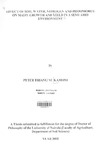| dc.description.abstract | A field study was carried out for three seasons from November 1999 to February 2001 to
investigate the influence of irrigation on growth, light and nitrogen use in maize under semiarid
conditions in Machakos, Kenya. The study also assessed the potential and applicability
of the World Food Studies (WOFOST) model in predicting maize growth and yield in the
same area. The work spanned three seasons namely short rains 1999 (SR1999, Nov. 1999-
March 2000); long rains 2000 (LR2000, April to August 2000) and SR2000 (November
2000 to March 2001). The rainfall received in the three seasons was 350, 143 and 534 mrn
respectively. The experimental design was randomized complete block design laid out as
split plot with water regime as main plots (irrigated, rainfed), nitrogen (N) (0, 50, 100 kg N
ha-I
) and phosphorus (P) (0, 25 kg P20S) factorially combined as subplots. Data collected
included leaf area index (LAI) , photosynthetically active radiation (PAR) interception,
maize grain yield, total dry matter (TDM) accumulation, nitrogen uptake and soil moisture.
Irrigation significantly increased TDM (at physiological maturity) by about 2 to 10 fold
during the study period. Grain yields were lowest in driest season (LR2000) (151 kg ha")
and highest (6,027 kg ha-I
) in wettest season (SR2000). Irrigation significantly increased
leaf area index (LAI) byabout2 fold (maximumLAI, 1.3,2.8 for rainfed and irrigated
respectively) in the dry season but had no effect in the wetter seasons. PAR interception
increased by the same factor as LAI (maximum PAR interception 33 %, 64 % for rainfed
and irrigated respectively in the dry season). Maize light extinction coefficient was lower
(0.30) under moderate and low water supply (rainfed SR1999 and LR2000) and higher
(0.37) under high water supply (irrigated LR2000 and SR2000). The total plant N uptake
was highest (175 kg ha-I
) in wettest season (SR2000) and lowest (14 kg ha-I
) in the driest
season. Irrigation increased N uptake by a factor of 2 and lOin the moderately wet season
and dry season respectively. Cumulative evapotranspiration was higher with irrigation in the
season with moderate rainfall (SRI999) by about 2 fold and 5 fold in the dry season
(LR2000).
Soil water extraction was higher in the fertilized maize (at 30 and 45 ern) compared to the
unfertilized maize in the three seasons. Nitrogen application improved TDM, grain yield,
LAI, PAR interception and N uptake in the seasons when water was not limiting (wet
season or under irrigation) in the three seasons. Light use efficiency ranged from 2.2 to 2.5
g/MJ with N application and high water supply and 1.04 g/MJ under low water supply
(rainfed).
The WOFOST model overestimated grain yield by 10 to 20 % because of overestimation
of partitioning coefficients. The prediction of the various variables (LAI, soil profile
moisture, leaves and stems dry matter, TDM and grain yield) were closer to measured
values under wet (278 to 534 mm rainfall) or irrigated conditions but were highly
overestimated (30 -765 %) under dry conditions (LR2000). This could bed ue to the
differences in dry matter partitioning under adequate water supply (used in model
calibration) and those under very dry conditions. The validation showed that reasonable
estimation (80 - 90%) of grain yield, leaves, stems and total dry matter can be made under
adequate water supply. The optimal N application was 50 kg ha-1 above which there was no
improvement in maize growth and yield. Supplementary irrigation can increase maize yield
even at low fertilizer input level in semi-arid Kenya. | en |

